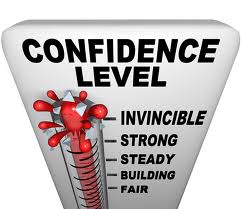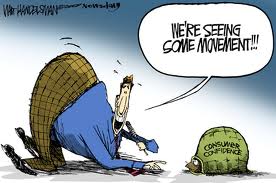By tothetick
A new Nielson survey on global consumer confidence for the 2nd quarter this year reveals that confidence is improving around the world. It works out to 55% of people around the world that believe that we are currently going through a recession, which means that this is the lowest figure surveyed for over two years. Although, one might wonder whether or not the 45% of the population that still do not believe that we are going through a recession are actually living in the same world.
Consumer Confidence: Up?
Or are they just optimistic? Believe and have faith, oh ye, of little faith. Nullfidians! You should believe in the divinities’ skills to bring us through the crash and out the other side of recession, shouldn’t you? Although, debatable as to whether or not there are actually any divinities out there right now. We could start a list. The good guys and the bad guys of the economy today, couldn’t we? I am sure there would be a few proposals for at least one side of that list.
The report published today by Nielson shows that there is a one-point rise to 94 for Q2 2013 confidence from Q1 2013, and that’s an increase of three points for the index of consumer confidence since Q2 2012.
Dr. Vankatesh Bala at The Cambridge Group subsidiary of Nielson states (in rather upbeat fashion) “While confidence in Europe remained in a holding pattern as financial conditions stabilized, perceptions about jobs, personal finances and spending intentions increased in the world’s three largest economies—U.S., China and Japan—which is having a beneficial effect around the world”.
But, one might also worry about the problems that are also coming from those self-same countries and that may not be boosting the world at all. Notable, one should take into consideration the slow-down in the Chinese economy and the sluggish recovery being experienced by the US, with the added worry that Quantitative Easing will be withdrawn in the not too distant future with Ben Bernanke’s game of cat and mouse. I’ll take it away; oh no I won’t.
Nielson’s survey was carried out with
- over 29, 000 people being interviewed in 58 countries around the world.
- There are still 55% of people that believe we are going through a recession in the world, but that is an improvement, at least, on 2011’s figure.
- It is also a 5% increase for the period 2008 to 2012.
- For that period 87% of US citizens that were polled thought that they were going through a recession.
Confidence: Spending on entertainment?
Apparently around the world spending is up and cash is more abundant. Discretionary spending or at least intentions to spend money in the future is also increasing, especially on vacations and new-technology products as well as entertainment. Just 14% of people polled stated that they had no spare cash to spend on entertainment and free-time. That was a 1% decrease on the first quarter of 2013.
The Asia-Pacific region had the largest increase in discretionary-spending intentions, increasing by 4% overall. 43% believe that they will spend spare money on vacations and 39% on new clothes. Home entertainment accounts for 38%. 61% of people in this region stated that they would save money, which points to the fact that they are not that certain that the economy will take a turn for the better quite yet. Although, traditionally, the region has always saved more than other regions for cultural reasons and planning ahead. Plus traditionally it seems hardly at all surprising that at this time of year confidence might be up just a little given the vacation period.
While global consumer confidence is up to 94 in Q2 statistics for 2013, in some regions that confidence is better than elsewhere. Consumer confidence increased to 96 in the USA (up 3 points in comparison with Q1 figures). In China that figure stood at 110, which is over the base line of 100 in the optimism-pessimism index. That was a two-point increase on Q1 figures. Japan also increased by two points to 78.
But in the EU, confidence decreased in 4 countries out of 29. It also had 9 out of ten of the lowest scores in global consumer-confidence figures overall. Portugal for example only has a figure of 33 with regard to confidence of their consumers.
Latin America is also suffering from a decline in consumer confidence for the second quarter 2013. This is a decline for two quarters now. Venezuela is down for the second consecutive quarter with an index of 68. Argentina is also down to 68 and Mexico stands at 84.
Pakistan is just ahead of the US with a confidence figure of 98 and that is an enormous increase of 11 points since Q1 2013.
However, it should be remembered that despite the large number of people that were polled, Nielson does use internet surveys as a means of getting these results. This might suggest that younger people, rather than a clear cross-section of all age groups are answering the questions. Young people might have a better, more positive approach to their futures rather than people who are going through the crises involving recessional effects. The survey is also based upon intentions to spend money or save money in the future and in no way bring into question the real spending of populations. In other words, what you intend to do is not necessarily what you will do given the current situation. However, Nielson states that they have a margin of error of plus or minus 6%.
Regardless of the intentions and the way the people polled actually identify with the economic crises at the present time, there are major worries that are felt such as consumer recovery being impacted by a rise in interest rates in the future. There is also the added problem of element such as house purchases (and whether this will continue) which are stopping consumer-confidence figures from rising more at the present time.
For example, in the US figures released in May 2013 showed a 29% increase over figures for May 2012 (now at 476, 000 from 369, 000). New data will be released tomorrow in the US by the US Census Bureau and the Department of Housing and Urban Development (Wednesday, July 24, 2013) at 10:00 am EDT (http://www.census.gov/newhomesales).
There are also questions being asked as to how unemployment will progress in the coming months. June’s figure stood at an unchanged rate of 7.6% (data issued on July 5th 2013). While employment rose in certain sectors such as leisure and entertainment industries, this seems far from surprising given the fact that the summer months tend to see an increase in those sectors anyway. Despite growing beliefs from some that the US economy is picking up, unemployment has remained flat since February this year. There was even an increase in unemployment for adult women in the US in June 2013 (6.8%). Long-term unemployed people also saw no change in their status (with a flat figure of 4.3 million in June also. These people have been unemployed for more than 27 weeks and they make up 36.7% of all the unemployed in the US. Long-term unemployment has decreased by a million people from June 2012 to June 2013, but, gains are far from significant today.
Consumer Confidence Showing Through?
It remains to be seen whether or not the Nielson report will show through in the general feeling of the economy. While there might be some growing feeling amongst people around the world that the economy is picking up globally, the results have yet to be felt in the real homes of people and their everyday lives.



No comments:
Post a Comment